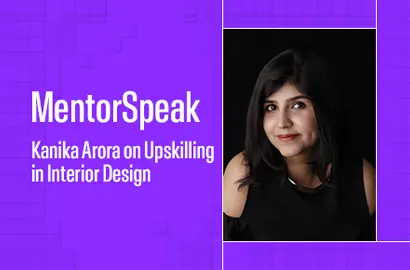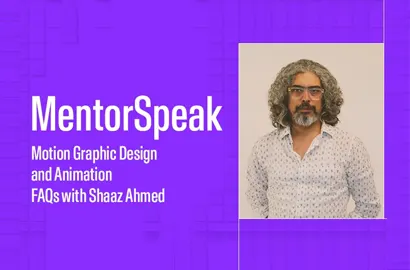In this first edition of MentorSpeak, we asked our mentors to answer some commonly asked questions about the design space, learning design, and AND Academy’s approach to design education. Read on to see what they have to say.
Whether you're just starting to learn design or want to upskill in order to advance your design career, the path ahead can seem quite daunting. However, the design space can also be quite rewarding so long as you have guidance from the right set of mentors. Voila - this edition of MentorSpeak is here to give you just that!
This article covers in detail some important and frequently asked questions regarding the design space and AND Academy, with answers from some of our esteemed faculty members. Let’s begin by getting to know a little bit about them.
- Prachi Mittal, Head of Academics at AND Academy - Prachi is a veteran design educator and researcher with over 20 years of experience in the industry, ranging across product design, social design, publication design and design management. She holds a PG Certificate in Higher Education from Kingston University, London.
- Rahat Varma, Course Lead for Interior Design at AND Academy - Rahat is an architect with over a decade of experience working on spatial design and has been associated with many renowned brands like Morphogenesis, Dekorate and mondo*arc.
- Soumya Tiwari, Course Lead for Graphic Design (Full-time Course) at AND Academy - Soumya has led the creative department in some of India’s biggest production houses, such as Yash Raj Films - Talent and Reliance Entertainment. She is an expert in art direction, branding and creative strategy.
Interested? Here is a breakdown of what we cover in this blog:
- How can I learn a practical discipline like design online?
- What kind of work will I be able to do with the skills I learn at AND Academy?
- Why should learners choose AND Academy over other similar learning platforms?
- What is learning at AND Academy like?
- Do I need prior design knowledge and experience to enrol at AND Academy?
Now that you’ve met the mentors, let's dive right into our mentors’ views on the most commonly asked questions about design.
Q.1. How can I learn a practical discipline like design online?
Prachi: If you’d asked me this question in 2018, I would've been a sceptic. Design is, after all, such a practice-based discipline. But now, having successfully mentored multiple batches in a remote setting, I believe that learning design online is very feasible. Several virtual platforms and software today make it extremely convenient for mentors to replicate a studio environment through online classes.
Our classes at AND are a lot more than just online lectures or webinars where a design educator is speaking and the learner’s job is limited to listening. We believe that the process of learning design needs the perfect balance of creative and strategic thinking. You can even say design learning is actually re-wiring your brain to think differently.
That is why all the classes at AND are active and interactive. We create a collaborative space where students are encouraged to partake in activities, discuss each other’s student work, and even learn from the approach their peers take to solve a problem.
The faculty here comprises both academicians and practitioners who are working in the industry and who bring with them years of expertise and tested knowledge. This allows us to ensure design education remains relevant to the current times as well as the future.
Rahat: In taking the learning experience for interior design online, we very carefully set up briefs to mimic real-world challenges. As the course progresses, we also encourage learners to go out and find clients as well as sites, so they can get a hang of what it’s like to actually work in the industry.
This experience helps learners in the selection of accessories, products and materials, and only enriches the design process at the end. It is essential for learners to be exposed to the communication and feedback loop that is an integral part of a real interior project. This is where interior design software like Coohom for 3D modelling and virtual pin-up boards like Miro comes to our rescue, by facilitating collaboration and iterative feedback.
Soumya: When you are working in the industry as a Graphic Designer, you are almost never functioning in isolation. So, it is essential that design institutes allow students the option to get critical opinions and new perspectives on their projects and sketches. We, therefore, wanted our graphic design course to be as closely related to actual industry practice as possible.
To facilitate an easy understanding of concepts, we use collaborative platforms like Miro and Canvas. Canvas is a learning management system that provides learners with consolidated access to all instructions, projects, class presentations and handouts. Miro, being an online pin-up space, helps us virtually replicate the brick-and-mortar experience of a display board while ensuring mentors can give feedback, review and work collaboratively with learners. I can access the board anytime, leave comments for my students or answer their queries. Students are not left isolated and there is a constant connection.
Q.2. What kind of work will I be able to do with the skills I learn at AND Academy?
Rahat: Talking about the interior design course at AND, there are several routes you can choose after completing it. You can start working with an Interior Design firm or join an architectural practice. Many of our students have begun their journeys by assisting established architects.
We also encourage students to open up their own practices. You can start with small-scale residential projects like kitchen design, and slowly progress to bigger projects like designing bedrooms or a villa. With experience, you can eventually switch to commercial projects like designing cafes, office spaces and hotel rooms. With retail breaking into the digital space, exciting possibilities like a design for sale and mock setups are also available.
Prachi: The UX UI course at AND covers the entire landscape of designing the user experience of a digital product. We start with user research, cover information architecture, and content management, and go all the way to interaction design and visual design.
After completing your course, you can join a user research team or a strategy team, work in visual design, or even choose to work in specialised roles like interaction design. There are many possibilities, with several opportunities to upskill in highly specialised fields as you progress.
Soumya: Graphic Design is one of the most versatile disciplines in the design space and offers excellent career growth. Considering the high demand for Graphic Designers in the present world, there are several routes you can explore. Brand identity design, promotion design, brand communications, book cover design and website layout design are some common career paths that Graphic Designers can consider. You can also move over to specialised fields like motion graphics or user experience.
Q.3. Why should learners choose AND Academy over other similar learning platforms?
Prachi: While all our learners have their own reasons for trusting us, I truly believe our strength as design educators lies in the organised approach we take towards design learning. Our experience at the Indian Institute of Art & Design (IIAD) - AND’s sister organisation - during the pandemic has not only equipped us with key insights into the challenges of virtual learning but has also helped us better understand the psychology of a learner.
When you join AND, you enter a well-established ecosystem that optimises learning for its students. Through robust planning and a thoughtfully choreographed series of experiences, we facilitate effective learning of key skills, knowledge and concepts.
Q.4. What is learning at AND Academy like?
Prachi: Meaningful learning only occurs when there is a synergy between content knowledge and pedagogical knowledge. As I mentioned previously, our experience at IIAD combined with all the learnings we gained during the pandemic has equipped us with rich knowledge resources. We now deeply understand the learner’s psychology and strive to create an environment that steers clear of passive design education. So it's safe to say our work at AND is deeply rooted in research, particularly in the realm of design education.
Soumya: In design schools, students usually sit together and work on projects in a collaborative environment. It is common practice for students to carry rough sketches and sheets for quick feedback.
To be able to replicate that experience, we use virtual pin-up spaces like Miro, where learners can put up all their student work in one place for both peers and instructors to drop quick suggestions or feedback on. We also do a lot of peer reviews in our sessions to equip learners to examine their work as well as the work of others in a critical light.
Rahat: Every AND interior design learner, at any given point in time, undertakes two projects - a demo project and a project of their own. As mentioned before, the projects at AND are created to replicate real-world challenges and experiences. Learners are encouraged to work alongside clients and actively interact with them to get a hang of the actual interior design process.
To facilitate communication and feedback between learners and mentors on the course, we use Miro. The other software we use in the course is Coohom, to assist in visualisation for projects.
Q.5. Do I need prior design knowledge and experience to enrol at AND Academy?
Rahat: Anyone who is observant can consider pursuing design, regardless of the educational and professional background they come from. I’ve witnessed learners with civil and electrical engineering backgrounds and absolutely no design experience pick up the relevant skills fairly well with practice. Even those with experience in a design field like fashion or graphic design can flourish in interior design.
Any prior knowledge or experience is always an asset, of course, but what is most important is that you tap into the creative side of design. So long as you take the right route to learning design and find an able set of mentors to guide you, prior experience and knowledge are not a necessity.
Prachi: Design knowledge or experience is not necessary to enrol for the UX UI Design course at AND. In fact, we have an interesting and diverse mix of learners in terms of their backgrounds.
There are people who have studied design in various disciplines including fashion, architecture, interior design and graphic design, but now want to explore the field of UI UX in detail. We also have people from engineering backgrounds, like BTech graduates, who are proficient with coding, but not so much with the creative process of user experience and interface design. Some of our learners come with work experience in sales or digital marketing and wish to upskill so that they can get into the user experience design of, say, an e-commerce site.
In other words, if you enjoy solving problems and if you enjoy the digital product space, then our UX UI Design course could be for you.
Soumya: Graphic design not only finds diverse applications but also attracts people from different backgrounds. Arts students, visual artists and people from non-design disciplines like English literature, Commerce, and even BTech often enrol in our courses and do a great job at learning graphic design. We’ve also had learners who are self-taught and are well versed with tools, but not particularly with design, enrolling in and benefiting from our course. To tend to such a diverse group, the course starts with the fundamental principles and slowly moves on to the complex concepts.
Those are all the questions we could pack into this edition of MentorSpeak, but rest assured, we will be back with more soon! For now, we hope this blog has answered a few questions that may have been riddling your mind and making you second-guess your intent to explore the design space.
For those of you looking for more detailed information, our Design Blog does a deep dive into UX UI Design, Graphic Design, and Interior Design. In case of further assistance or information, you can contact our Course Advisors.
Note: All information and/or data from external sources is believed to be accurate as of the date of publication.






